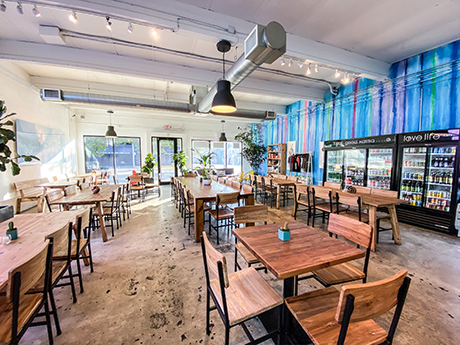Pictured is the interior of Love Life Cafe, a plant-based dining concept that recently opened in the 545wyn office building in Miami’s Wynwood neighborhood.
When the world shut down in March 2020, “Chicken Littles” everywhere proclaimed the end of one of commercial real estate’s main asset classes: retail. Retail tenants have largely abandoned their expansion plans and entered survival mode focusing on seeking rent reductions and lease restructurings.
Financially fragile landlords fought to service large debts, while those in stronger positions took the opportunity to evict struggling tenants and renew inventory, hoping more creditworthy tenants would come calling.

Gianna Blanco, NAI Miami
Fast forward two years and any lingering uncertainty about the survival of retail has faded and today we appear to be in one of the strongest owner markets in recent memory. What led to this drastic shift from fear and hesitation to boundless optimism in the market?
Increased competition among tenants with strong financial support. Two factors have changed the landscape: private equity-backed healthcare companies and capital-rich restaurant groups.
Medtail in Miami
Healthcare businesses appeared to thrive during the pandemic, as most were able to remain operational thanks to state and local “shutdown” orders. Many of these businesses have taken advantage of the pandemic to pounce on the large spaces freed up by big-box retailers and service-oriented businesses, such as nail salons, hair salons and dry cleaners that could no longer pay their rent with less foot traffic.
Primary care groups and urgent care clinics, especially those guided by savvy private equity sponsors, covet the marketability and accessibility of ground floor retail space – they are no longer content of “Medical Office Building Suite 303” overlooking the parking lot. Vacant retail spaces ranging from 3,000 to 15,000 square feet were quickly filled by these growing medical groups.
Given the resilience of health care, regardless of the economic climate, these businesses have the confidence to list prime rents, driving up rental rates in the market.
time to eat
Large restaurant groups also had the financial wherewithal to survive the pandemic and began gobbling up second-generation spaces between 1,500 and 3,000 square feet to expand their operations with new and established concepts. Out-of-state groups appeared to be leading the charge, and for the past 18 months, landlord representatives have fielded weekly calls from numbers with area codes corresponding to the northeast.
These foreigners seem to have been lured to Florida by lax COVID-19 restrictions, lower taxes and year-round sunshine. Faced with rising construction costs, many restaurateurs have felt opportunistic and focused only on second-generation spaces, even if they are not ideally located. They seemed content to trade high rents for the perceived “ease” of fitting a second-generation space.
However, while healthcare companies generally stick to standard builds, restaurateurs need custom layouts, especially when establishing new concepts. And, while there are many advantages to renting out a former restaurant space with infrastructure (ie.
Given Miami’s overwhelmed and inefficient municipalities, it often takes restaurateurs twice as long as they think to complete a build. Indeed, it can now take three to five months to obtain the approval of the building permits after the filing of the architectural plans. An additional wildcard is that many spaces require upgrades to comply with current zoning codes.
For example, Wynwood, a historically industrial neighborhood, has now become a dense submarket of retail, office, and apartment living.
This change required the new tenants to upgrade their water pipes and create additional grease interceptors. Foreigners unfamiliar with Miami’s zoning codes now find themselves stuck in the mire of local permit bureaucracy while paying high rents.
Will the struggle with zoning requirements and the construction schedule start to discourage these out-of-town restaurant groups from coming to Miami?
Between the third and fourth quarters of 2021, commercial real estate brokers saw a contraction in retail inventory of about 4% in most Miami-Dade County submarkets.
Our best guess of what the Miami retail market will look like over the next two years is that there will be a new wave of vacancies as restaurant profit margins are squeezed by high rents and the impact of inflation on operating costs.
Out-of-state groups hungry for long restaurant lines and crowded hotels in Miami may struggle with restaurant openings delayed by unexpected permit quagmires.
On the other hand, large restaurant groups and healthcare companies should do well due to price inelasticity among customers who frequent high-end restaurants and the inherently unlimited demand for health, respectively.
Consider further that these businesses will be better positioned to pay competitive wages in a shrinking job market, and there doesn’t appear to be an “easy” path for displaced service-oriented retailers to re-enter the few highly desirable spaces still available. Stay tuned.
— By Gianna Blanco, Vice President, NAI Miami. This article originally appeared in the May 2022 issue of Southeast real estate company.

